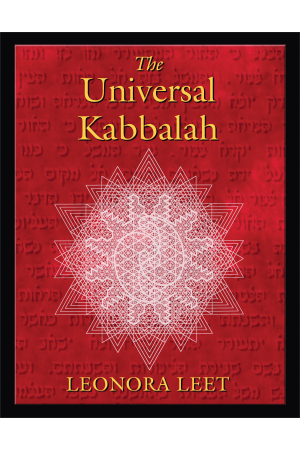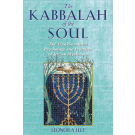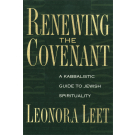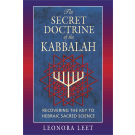The Universal Kabbalah
- Pages: 528
- Book Size: 8.5 x 11
- ISBN-13: 9780892811892
- Imprint: Inner Traditions
- On Sale Date: September 29, 2004
- Format: Hardcover Book
- Illustrations: Includes 16-page color insert and 79 b&w line illustrations
• Explores three higher levels of consciousness above the four worlds of the classical Kabbalah
• Reveals the mathematical code of the laws of all cosmic manifestation
This landmark work by an innovative modern Kabbalist develops a scientific model for kabbalistic cosmology and soul psychology derived from the kabbalistic diagram of the Tree of Life and the author's own Sabbath Star diagram--a configuration of seven Star of David hexagrams. This geometric model begins with the four worlds of the classical Kabbalah, which bring us to the present time and birthright level of the soul, and is then expanded to three higher enclosing worlds or levels of evolving consciousness. The Sabbath Star diagram therefore accommodates both the emanationist cosmology of the earlier Zoharic Kabbalah and the future orientation of the later Kabbalah of Isaac Luria. The hexagram elements that construct each expansion of the Sabbath Star diagram configure the cosmic stages of each of its “worlds.” The matrix that is produced by these construction elements configures the level of the multi-dimensional soul that is correlated with each cosmic world. In its final stage, this model unites the finite and infinite halves of the Sabbatical world in a way that exemplifies the secret doctrine of the Kabbalah.
Not only does this work offer a new, inclusive model for the Kabbalah but it also provides a basis for complexity theory, with its final extrapolation to infinity. The universality of this model is further shown by its applicability to such other domains as physics, sociology, linguistics, and human history. This universal model encodes the laws of all cosmic manifestation in terms that are particularly coherent with the formulations of the Kabbalah, giving a mathematical basis to many aspects of this mystical tradition and providing a new synthesis of science and spirituality for our time that may well write a new chapter to the Kabbalah.
Chapter One: The Star and the Tree
Hebraic and Pythagorean Sacred Science
At the heart of most sacred traditions lies a holy diagram in which the knowing can read a record of cosmological history, the ritual use of such forms of illumination attesting to the understanding, long before Kepler, that "God forever geometrizes." In the Zohar, the central work of the Jewish mystical tradition broadly designated as the Kabbalah, allusion is made at the very beginning to a diagram underlying all creation, a diagram whose existence in the supernal thought is said to have been first disclosed through the direct revelation of Elijah:
This mystery remained sealed until one day, whilst I was on the sea-shore, Elijah came and said to me. . . ."Master, the Holy One, blessed be He, had a deep secret which He at length revealed at the celestial Academy. It is this. When the most mysterious wished to reveal Himself, He first produced a single point which was transmuted into a thought, and in this He executed innumerable designs, and engraved innumerable gravings. He further graved within the sacred and mystic lamp a mystic and most holy design, which was a wondrous edifice issuing from the midst of thought. This . . . was the beginning of the edifice, existent and non-existent, deep-buried, unknowable by name. . . . And upon this secret the world is built.
The fact that the name of this "most holy design" is said to be "unknowable" suggests that it is not the famous Tree of Life Diagram, a detailed geometric design that forms the basis of most later kabbalistic thought and that would already have been known by the author or final redactor of the Zohar in thirteenth century Spain. It is just such a more hidden diagram that is the subject of this work, one that was discovered through the key of the Tree of Life Diagram and that, because it features a unique configuration of seven hexagrams, or Stars of David, has been named the Sabbath Star Diagram.
In its form and derivation, it serves to combine the two major geometric expressions of the Kabbalah, the Star of David and the Tree of Life Diagram, the star and the tree, whose symbolic association spans the millennia from the cartouche proclaiming the Pharaoh to be King of Lower Egypt to the decorative motifs identified with the Christmas celebration, an association that seems to express the universal spiritual understanding that all that grows on earth is fertilized from above. Initially constructed from the mysterious arrangement of hexagrams required to explain the geometric derivation of the Tree of Life Diagram, this underlying cosmological construction not only provides a geometric demonstration of the principles of kabbalistic cosmology but a geometric model applicable both to kabbalistic concepts of the soul and modern scientific theories, a model that lends support to the esoteric belief that matter and spirit are homologous structures of a coherent cosmos.
Unlike the seemingly arbitrary arrangement of the Tree of Life Diagram, the Sabbath Star Diagram becomes a self-generating geometric construction following its own discoverable laws of expansion. Whatever may be the source of the Tree of Life Diagram, it can, in fact, be argued that its purpose was not only to model the esoteric cosmology identified with the Kabbalah but to serve as an initiatic key to unlocking this more complex but also more intelligible geometric construction, one whose geometric processes appear to encode with uncanny precision the archetypal principles of cosmic development.
Whether or not the Tree of Life Diagram has ever been previously used to unlock this more hidden diagram, it enabled me to discover both the geometric laws of its construction and the methodology appropriate to interpret its implications.
For the Tree of Life Diagram is not simply an arrangement of various circles and the lines connecting them; its parts are named and their spatial relationships given an associative mythological interpretation. Thus the kabbalistic geometry of the Tree is distinguished by its quasi-talmudic approach to geometric form as something very much like a literary "text," one whose meanings must be grasped not through logical demonstration but mythological association.
The methodology of kabbalistic geometry explains how it is possible to "read" a geometric form as a sign, to construe its meaning and translate its absolute truth into a secondary order of mythological explanation. For in addition to such use of precise geometric processes to model creation as we shall see can be found in the Zohar as well as in Genesis, the Kabbalah developed its distinctive approach to geometry in which form could not be separated from cosmological interpretation. It is this method in which the Sabbath Star Diagram is derived from the key of the Tree of Life Diagram in an elementary version that is expressive at every stage of its development of cosmological implications consistent with the basic principles of kabbalistic cosmology, initially its concept of four cosmic worlds.
It is this remarkable coherence between the Sabbath Star Diagram and kabbalistic cosmology that will be explored in this work as each expansion of the diagram takes us to new worlds and levels of consciousness. In the process, the Kabbalah of the Tree of Life Diagram will be both elucidated and shown to be coherent with the broader Jewish esoteric tradition originating with the Bible. All aspects of this tradition will find their place in the unified Sabbatical cosmic structure that the seven expansions of the Sabbath Star Diagram can so well model, a structure that contains both the four worlds of emanation of the classical Kabbalah and the future worlds of rectification projected by both the normative Messianic tradition and the Lurianic Kabbalah. The development of such a seven-dimensional cosmic model wholly interpreted in terms of Jewish esoteric cosmology and its correlated concept of soul levels represents an approach to the interpretation of geometric form that is new to modern mathematical science.
Foreword by Dr. Julian Ungar-Sargon
Note from the Publisher
Preface
PART ONE
Introducing a New Model for the Kabbalah
1 The Star and the Tree
Hebraic and Pythagorean Sacred Science
The Hexagram and Hebraic Sacred Science
The Hexagram: An Esoteric Key to Genesis and the Zohar
The Hexagram of Creation
A Further Study of Jewish Cosmology
2 The Sabbath Star Diagram
Discovering the Geometric Source of the Tree of Life Diagram
The Science of Expressive Form
A General Preview
PART TWO
A New Model for Kabbalistic Cosmology
3 Generation of the Fourth-World Diagram
A Summary Introduction to the Fourth-World Diagram
Generating the Fourth-World Diagram
The Fourth-World Diagram and the Fall
The Fourth-World Diagram and the Transformative Moment
The Sabbatical Model of Redemption
The Trivalent Logic of the Sabbath Star Diagram
4 The Evolution of the Fourth World
Preliminary Definition of the Sabbath Stars
The Sabbath Stars of Yetzirah
The First Sabbath Star of Asiyah and the Minerals
The Second Sabbath Star of Asiyah and the Plants
The Third Sabbath Star of Asiyah and the Animals
The Fourth Sabbath Star of Asiyah and Man
5 The Fifth-World Diagram and the Messianic Age
Introduction to the Fifth World Diagram
The Fifth-World Sabbath Stars and the Messianic Age
Stages of Ruach Consciousness
6 The Sixth-World Diagram and the World to Come
A Manual for Sixth-World Diagram Construction
The Laws of Diagram Construction and Number Theory
The Construction Elements and Gender
The Construction Elements and the Partzufim
7 The Culminating Diagram of the Cosmic Octave
Construction Elements of the Octave Diagram
The Unification of the Name
The Working of the Chariot
The Octave Diagram and the Tzimtzum
The Angels of Aravot
PART THREE
A New Model for Kabbalistic Soul Psychology
8 The Fourth-World Matrix Model of the Nefesh Soul
Understanding the Hexagram Matrix
The Dual Spiral Matrix in Its Unfallen and Fallen Forms
Temptations beyond the Matrix Border
9 The Fifth-World Matrix Model of the Ruach Soul
Primary Definition of the Fifth-World Matrix
The Ruach Matrix Model of Meditation
The Levels of Ruach Master Power
10 The Sixth-World Matrix Model of the Neshamah Soul
The Completed Pattern of the Spiral Tree
The Matrix Partzufim
The Sefirot and the Path of the Soul
The Spiral Tree as Psychological Model
The Fourth- and Fifth-World Matrix Models of the Nefesh and Ruach Souls
The Sixth-World Matrix Model of the Neshamah Heart
The Sixth-World Matrix Model of the Neshamah Mind
11 Forbidden Crossings and the Illusion of Knowledge
Introduction: Tohu or Tikkun?
Beyond the Fourth-World Matrix Borders
Beyond the Fifth-World Matrix Border
Beyond the Sixth-World Matrix Border
Light Units and the Illusion of Knowledge
12 The Octave Matrix of the Chayah Soul
Cherubs and Trees
The Double Spiral Tree: Redemption through the Other Side
The Sixfold Cherub Tree and the Measure of the Body
PART FOUR
A New Model for the Infinite
13 Exploring the Geometry of the Infinite beyond the Cosmic Circle
The Seventh World
The Eighth World
The Ninth World
14 Charting the Infinite Future
Extrapolating the Matrix to Infinity
The Relationship of Construction and Matrix Elements
15 The Final Model of Infinity: The Sabbath Star System
The Periodic Decimal Sequence
The Converging Decimal Sequence
Convergence and the Law of Complex Magnitudes
APPENDICES
A New Universal Model
A Scientific Implications of the Hexagram Matrix
B A Systems Model of Sociology
C Systematic Linguistics
D A Gender Model of Human History
Notes
Index
Rabbi Zalman M. Schachter-Shalomi, leader of the Jewish Renewal Movement and coauthor of From Age-ing to Sage-ing
“Leet will become known to be among the greatest Kabbalists of this time.”
Ralph Abraham, author of Chaos, Gaia, and Eros
“The Universal Kabbalah is a prodigious work of meticulous scholarship and creative instinct. Leet combines the usual text work done by kabbalah researchers with an exhaustive examination of the geometric keys to understanding our cosmos and the soul’s journey through its levels, or worlds.”
Thomas Peter von Bahr, New Age Retailer, Fall 2005
“The Universal Kabbalah is an important contribution to knowledge that makes available at great depth material that up to now was locked up in Hebrew texts. Serious study of this text produces a holographic approach to the cosmos, and questions regarding philosophical contradictions disappear in the perspective of the cosmic architecture the book reveals. It is a seminal work that will become a classic.”
--Rabbi Zalman M. Schachter-Shalomi, leader of the Jewish Renewal Movement and coauthor of From Age-ing to Sage-ing
“Leonora Leet’s discoveries are highly original and play a key role in the completion of the picture of early Jewish mysticism, restoring its rightful place in contemporary religious life. . . .I believe Leet will become known to be among the greatest kabbalists of this time.”
--Ralph Abraham, author of Chaos, Gaia, and Eros
This landmark work by an innovative modern kabbalist reveals the mathematical code at the base of the laws of all cosmic manifestation. The author presents a scientific model for kabbalistic cosmology and soul psychology derived from the kabbalistic diagram of the Tree of Life and her own Sabbath Star Diagram--a configuration of seven Star of David hexagrams. This geometric model begins with the four worlds of the classical Kabbalah and is then expanded to three higher enclosing worlds or levels of evolving consciousness. The Sabbath Star Diagram therefore accommodates both the emanationist cosmology of the earlier Zoharic Kabbalah and the future orientation of the later Kabbalah of Isaac Luria. The author takes us through the seven spiritual worlds of the Kabbalah and relates them to the conscious development of the soul. By showing the soul the way through these spiritual “worlds,” the author takes us to the final stage of the Kabbalah where the finite and infinite are united and the secret doctrine of the Kabbalah is revealed.
Not only does this work offer a new, inclusive model for the Kabbalah but it also provides a basis for complexity theory, with its final extrapolation to infinity. The universality of this model is further shown by its application in the domains of physics, sociology, linguistics, and human history. This universal model encodes the laws of all cosmic manifestation in terms that are particularly coherent with the formulations of the Kabbalah, giving a mathematical basis to many aspects of this mystical tradition and providing a new synthesis of science and spirituality for our time that may well write a new chapter to the Kabbalah.
LEONORA LEET (1929-2004) received her Ph.D. from Yale University and was a professor of English at St. John’s University who specialized in Renaissance literature, a field in which she published widely. She pursued her study of the Kabbalah and Jewish spirituality under noted kabbalist Aryeh Kaplan and Zalman Schachter-Shalomi and found support for her work in scholars such as Stanley Krippner, Martin Samuel Cohen, Robert Zoller, Santosh Desai, John Anthony West, Joscelyn Godwin, and Robert Lawlor, with whom she studied Pythagorean geometry at Lindisfarne Institute.
Leet’s previous books on the Kabbalah are Renewing the Covenant, The Secret Doctrine of the Kabbalah, and The Kabbalah of the Soul.










